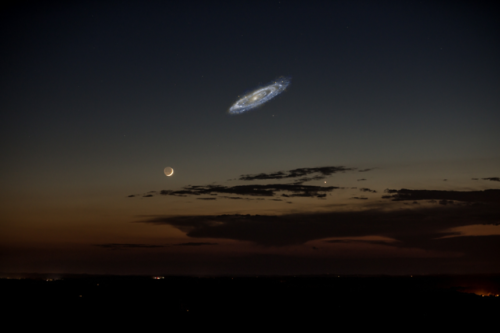If You’re Not Amazed By The Stars On A Clear Night Then We Won’t Work.
If you’re not amazed by the stars on a clear night then we won’t work.
More Posts from Riekod and Others
:’(

The IAU reclassifies Pluto as a dwarf planet. (2006)

Chemistry: Burning up alcohol
Source
“The most exciting phrase to hear in science, the one that heralds new discoveries, is not ‘Eureka!’ (I’ve found it!), but ‘That’s funny…’”
— Isaac Asimov | Author - I, Robot | Professor - Biochemistry


M43 - Part of the same star-forming complex as the Great Orion Nebula (M42)

Omega Centauri.
Credit: Maicon Germiniani
Productivity culture will deceive you (especially if you are particularly high-functioning or a former Gifted Kid) into thinking that any use of your time that can’t be monetized or leveraged for your personal advancement is worthless, and I’m here to tell you that’s the devil talking. Do shit because you like it.

Andromeda’s actual size if it was brighter
via reddit


Liquid oxygen is magnetic
Liquid oxygen sticks between the poles of a strong magnet until it boils away into its gas state. This is because it has unpaired electrons, which make each oxygen molecule a tiny magnet with a dipole. Normally, when oxygen is in a flask or in the air, these microscopic magnets point in all directions, cancelling out and meaning that there’s no net magnetic field. When it pours over the permanent magnet, the magnetic molecules all slightly align, creating an induced magnetic field, which reacts with the permanent magnet, making the oxygen stick to the poles. This is called paramagnetism. Click here to watch the video.
A Mesmerizing Model of Monster Black Holes
Just about every galaxy the size of our Milky Way (or bigger) has a supermassive black hole at its center. These objects are ginormous — hundreds of thousands to billions of times the mass of the Sun! Now, we know galaxies merge from time to time, so it follows that some of their black holes should combine too. But we haven’t seen a collision like that yet, and we don’t know exactly what it would look like.

A new simulation created on the Blue Waters supercomputer — which can do 13 quadrillion calculations per second, 3 million times faster than the average laptop — is helping scientists understand what kind of light would be produced by the gas around these systems as they spiral toward a merger.
The new simulation shows most of the light produced around these two black holes is UV or X-ray light. We can’t see those wavelengths with our own eyes, but many telescopes can. Models like this could tell the scientists what to look for.
You may have spotted the blank circular region between the two black holes. No, that’s not a third black hole. It’s a spot that wasn’t modeled in this version of the simulation. Future models will include the glowing gas passing between the black holes in that region, but the researchers need more processing power. The current version already required 46 days!

The supermassive black holes have some pretty nifty effects on the light created by the gas in the system. If you view the simulation from the side, you can see that their gravity bends light like a lens. When the black holes are lined up, you even get a double lens!
But what would the view be like from between two black holes? In the 360-degree video above, the system’s gas has been removed and the Gaia star catalog has been added to the background. If you watch the video in the YouTube app on your phone, you can moved the screen around to explore this extreme vista. Learn more about the new simulation here.
Make sure to follow us on Tumblr for your regular dose of space: http://nasa.tumblr.com.
-
 kaittouchthis reblogged this · 3 weeks ago
kaittouchthis reblogged this · 3 weeks ago -
 justabratt reblogged this · 3 weeks ago
justabratt reblogged this · 3 weeks ago -
 sweetestscream reblogged this · 3 weeks ago
sweetestscream reblogged this · 3 weeks ago -
 sweetestscream liked this · 3 weeks ago
sweetestscream liked this · 3 weeks ago -
 spreadlovelivegood reblogged this · 3 weeks ago
spreadlovelivegood reblogged this · 3 weeks ago -
 spreadlovelivegood liked this · 3 weeks ago
spreadlovelivegood liked this · 3 weeks ago -
 just-emm reblogged this · 3 weeks ago
just-emm reblogged this · 3 weeks ago -
 brandondoesstuff reblogged this · 3 weeks ago
brandondoesstuff reblogged this · 3 weeks ago -
 iihthrr reblogged this · 3 weeks ago
iihthrr reblogged this · 3 weeks ago -
 kissingupyourinnerthighs reblogged this · 3 weeks ago
kissingupyourinnerthighs reblogged this · 3 weeks ago -
 shadowanndeath reblogged this · 3 weeks ago
shadowanndeath reblogged this · 3 weeks ago -
 sherpazoemookie10905 liked this · 3 weeks ago
sherpazoemookie10905 liked this · 3 weeks ago -
 a-fervent-revision liked this · 3 weeks ago
a-fervent-revision liked this · 3 weeks ago -
 tovbekarburak liked this · 3 weeks ago
tovbekarburak liked this · 3 weeks ago -
 vitabreviss reblogged this · 3 weeks ago
vitabreviss reblogged this · 3 weeks ago -
 itwillgetbetteriswearitwill liked this · 3 weeks ago
itwillgetbetteriswearitwill liked this · 3 weeks ago -
 mer-c-ar liked this · 3 weeks ago
mer-c-ar liked this · 3 weeks ago -
 martha-speaks reblogged this · 3 weeks ago
martha-speaks reblogged this · 3 weeks ago -
 jasthegh0st reblogged this · 3 weeks ago
jasthegh0st reblogged this · 3 weeks ago -
 jasthegh0st liked this · 3 weeks ago
jasthegh0st liked this · 3 weeks ago -
 lunalejanaa liked this · 3 weeks ago
lunalejanaa liked this · 3 weeks ago -
 vitabreviss liked this · 3 weeks ago
vitabreviss liked this · 3 weeks ago -
 delightfulmentalitypenguin liked this · 3 weeks ago
delightfulmentalitypenguin liked this · 3 weeks ago -
 amethyst-serenade reblogged this · 3 weeks ago
amethyst-serenade reblogged this · 3 weeks ago -
 aleariel reblogged this · 3 weeks ago
aleariel reblogged this · 3 weeks ago -
 arsid-mataj liked this · 3 weeks ago
arsid-mataj liked this · 3 weeks ago -
 coloradodom79 liked this · 3 weeks ago
coloradodom79 liked this · 3 weeks ago -
 justanotherhumandisorder liked this · 3 weeks ago
justanotherhumandisorder liked this · 3 weeks ago -
 mistressguillotine liked this · 3 weeks ago
mistressguillotine liked this · 3 weeks ago -
 decembercamiecherries liked this · 3 weeks ago
decembercamiecherries liked this · 3 weeks ago -
 allherfaeriesmeetinjuly liked this · 3 weeks ago
allherfaeriesmeetinjuly liked this · 3 weeks ago -
 fireandlove liked this · 3 weeks ago
fireandlove liked this · 3 weeks ago -
 octoberrr29th reblogged this · 3 weeks ago
octoberrr29th reblogged this · 3 weeks ago -
 octoberrr29th liked this · 3 weeks ago
octoberrr29th liked this · 3 weeks ago -
 snitchesgetswitches reblogged this · 3 weeks ago
snitchesgetswitches reblogged this · 3 weeks ago -
 generalfrankythe69th liked this · 3 weeks ago
generalfrankythe69th liked this · 3 weeks ago -
 xmementoviverex liked this · 3 weeks ago
xmementoviverex liked this · 3 weeks ago -
 coolstorybrahhh reblogged this · 3 weeks ago
coolstorybrahhh reblogged this · 3 weeks ago -
 puries reblogged this · 3 weeks ago
puries reblogged this · 3 weeks ago -
 d35kpop liked this · 3 weeks ago
d35kpop liked this · 3 weeks ago -
 here4smvt liked this · 3 weeks ago
here4smvt liked this · 3 weeks ago -
 howmanymoretimes liked this · 3 weeks ago
howmanymoretimes liked this · 3 weeks ago -
 ladysnorkles liked this · 3 weeks ago
ladysnorkles liked this · 3 weeks ago -
 pandorasxlovexx reblogged this · 3 weeks ago
pandorasxlovexx reblogged this · 3 weeks ago -
 grossbaby07 reblogged this · 3 weeks ago
grossbaby07 reblogged this · 3 weeks ago -
 buniculus reblogged this · 3 weeks ago
buniculus reblogged this · 3 weeks ago -
 lilheathen7 liked this · 3 weeks ago
lilheathen7 liked this · 3 weeks ago -
 sweetbabygirlfordad reblogged this · 3 weeks ago
sweetbabygirlfordad reblogged this · 3 weeks ago -
 whiskeytavernroom reblogged this · 3 weeks ago
whiskeytavernroom reblogged this · 3 weeks ago -
 ganagetyou reblogged this · 3 weeks ago
ganagetyou reblogged this · 3 weeks ago